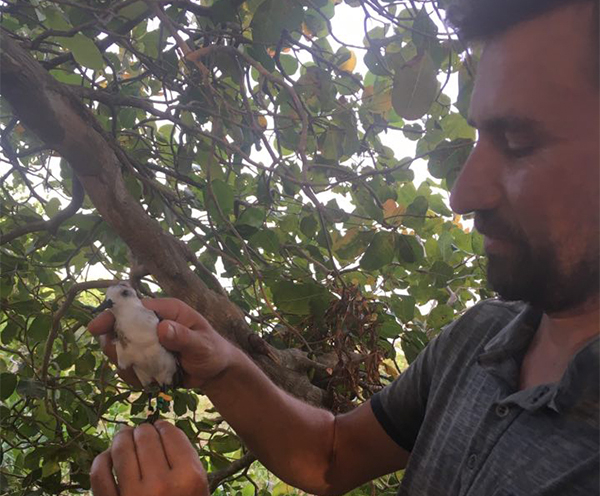Catching birds at the Bijagós Archipelo in Guinea-Bissau
11 November 2019, Imbone, Bijagós Archipelo, Guinea-Bissau
6:30 am. In the first light of the day we place our catching net at the high-tide watermark. The place where we set the net was carefully chosen; yesterday we observed many shorebirds to roost here with high tide. Around 8 am all is set. The sun climbs and the temperature increases. We hide under a few trees that border the shoreline. The tide is flooding now, and birds, mainly bar-tailed godwits, whimbrels, red knots and sanderlings, arrive in small flocks at the beach at their high-tide roost. When the numbers of birds increase, more birds start to move towards the net. Nervous communication on the radio. How many birds are there in the catching area? Which species? It takes ages, but finally, around 10 am, we agree that this is the right moment for action. Then things go fast. José gives the sign on the radio. 3-2-1 FIRE!
A loud bang, large flocks of birds taking off and people from everywhere run towards the net. Yes! Although most birds took off, we managed to get about 150 birds under our net. Quickly we lift the net out of the surf to make sure birds don’t get drowned and put a shade over the net to prevent birds from overheating. And then we patiently start extracting the birds, one by one. Just over one hour later all birds are extracted and we can start to process them in our provisional field camp. The birds get metal and colour rings, we measure their biometrics, weigh them, and, most importantly, equip a selected few with a miniature tracking device. On this day we would put 10 devices on bar-tailed godwits and 3 on whimbrels. A huge success. It feels like we finally figured out how to catch bar-tailed godwits in the Bijagós.
In the coming months (and hopefully years!) we can follow (in real-time!) how these birds move within the Bijagós. Specific questions that we hope to answer are: where do the birds forage and where do they roost and how do birds prepare for the northward migration in spring. We also want to understand the movement of these birds in relation to their macrozoobenthic (invertebrate) food. Earlier reports suggest that macrozoobenthic standing stock densities are relatively low in the Bijagós area, but it is largely unknown how birds deal with these low food stocks. An important part of this latter question is to establish the wader foodscape by means of synoptic mapping of benthos, which is scheduled for next year’s field season.
Another question that we aim to answer is how birds react to disturbance by humans. Unintentionally, we can study this question in a natural experiment, as we observed extensive construction works of a newly build hotel at one of the sites where we tagged birds last year. This site, Bruce, at the south of the island of Bubaque, was until last year an important roosting area for 130-650 shorebirds. There were no birds roosting at this location this year (we visited the place with high tide on 20 November). The tracking data should give a detailed picture on the impact of how such construction works on shorebirds

Another major goal of the study is to establish the level of connectivity between the Bijagós and other sites along the East Atlantic Flyway. The connection with the Netherlands is obvious. Last spring we obtained tracks of 5 bar-tailed godwits and all visited the Dutch Wadden Sea in spring.
The connection between sites became very tangible during this expedition as we caught a 47-gram sanderling that was marked 1.5 year earlier in the Netherlands at the island of Griend. NIOZ-researcher Roeland Bom participated in both catches!

During our expedition we enjoyed the enormous biodiversity of the Bijagós area. Especially eye-catching were the megafauna, including monkeys, hippopotamus and crocodiles. It is impressive to realise that the shorebirds that winter in the Bijagós are the same birds that make stop-overs in ‘our’ Wadden Sea, an area that is heavily affected by humans. In summer, these birds move to arctic breeding grounds, where they share their habitat with, among others, arctic foxes and polar bears, and where they are massively challenged by climate change.
The data obtained from the tracked birds should ultimately give us an intimate picture of how these globe trotters cope with all these (rapidly changing) different worlds.
The Bijagós is a fascinating place to visit. It harbours extensive number of shorebirds; in terms of numbers, it is the second most important wintering area for shorebirds (Banc d’Arguin in Mauritania is the winner). Shorebirds forage on the mudflats during low tide. With about 160.000 ha of mudflats, the area is roughly the size of the Dutch part of the Wadden Sea. The video shows how shorebirds, mainly bar-tailed godwits and whimbrels leave the roost and embark on a foraging trip (credits Roeland Bom).
This research is part of the international collaborative ‘Waders of the Bijagos’ project funded by the MAVA Foundation. The important additional funding from the Gieskes-Strijbis Fonds (Amsterdam, The Netherlands, to Theunis Piersma in the context of the project ‘Waakvogels) that enabled the procurement of a good number of satellite transmitters.